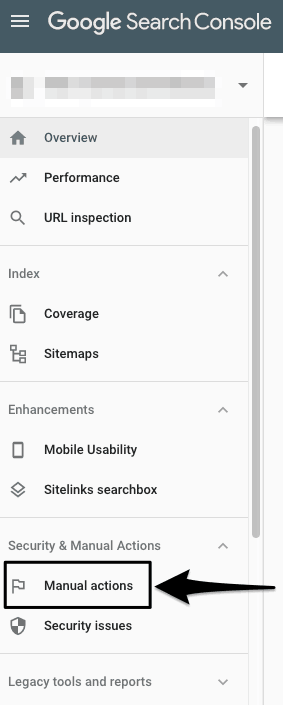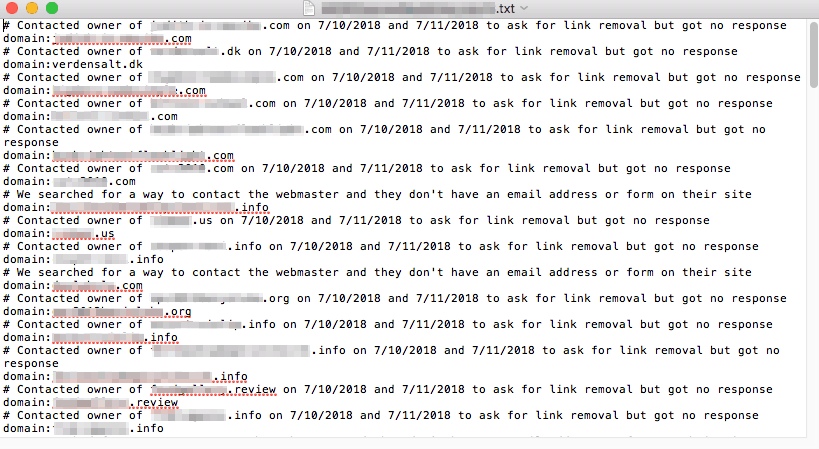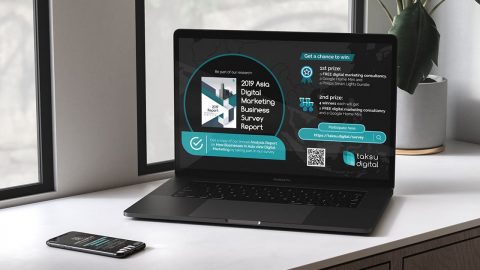If you own or manage a website that heavily depends on organic traffic from Google to keep it running, then waking up to a penalized website is definitely one of the worst things that can happen to your online business.
What is a Google Penalty or Manual Action?
A Google Penalty is a punishment that Google imposes on a website for breaking its Webmaster Guidelines. These penalties consist of Google taking either a single page or the entire website completely off their search results or by dropping the website’s rankings considerably, making it impossible or very difficult to be found on Google search results.
These changes happen immediately after Google decides the website has breached the Webmaster Guidelines. These penalties are also called manual actions because, in these cases, an actual human being takes the action against a website after a careful revision of its content, rather than Google’s algorithm.
As stated before, Manual Actions can be imposed for a variety of reasons, and we’ll go over them one by one, but first, let’s go over Google’s Webmaster Guidelines.
Simply put, Google Webmaster Guidelines are a set of general rules a website (or a webmaster) must follow in order to get indexed by Google’s algorithm, thus making the site visible on their search results. The webmaster guidelines basically make sure websites publish only original, safe, non-spammy and valuable content, ensuring Google only displays the best content available on the web.

Why did I get a Google Penalty?
There are several reasons why a website or a webpage could get penalized by Google. These are the most common ones:
→ Google penalty for link building & link schemes
Participating in any kind of link scheme goes against Google’s Webmaster Guidelines. This includes buying links, exchanging links, commenting on forums, and massive guest posting campaigns.
- Buying links includes links you get in exchange for something; it could be money but it could also be “free” products or services. For example, if you get any sort of product or service in exchange for a review on your website and that review includes links to their website, that could be counted as a link scheme and could get you in trouble.
- Exchanging links refers to two or more websites that link to each other. While this practice might casually happen, if Google detects a pattern and believes the links are part of a scheme, then they may proceed with the penalty.
- Commenting on forums and adding links to your own website is an old and spammy practice. While it seems like an easy way to get backlinks, the truth is that most forums do not allow the publishing of any comments with links, or if they do, they are published with a nofollow or the new rel=”ugc” tag to indicate user-generated content.
- A guest posting campaign is not necessarily a bad practice, but Google does not like it when it gets excessive or irrelevant. While you might be writing excellent articles and be legitimately collaborating with other websites, if it becomes spammy, repetitive, and extremely salesy, you might also get in trouble.

→ Google penalty for duplicate content & automatically generated content
Not all automatically generated content is spammy. The problem with automatically generated content is that it tends to be content copied from other websites, which most likely falls into copyright infringement and duplicate content. Remember, Google likes it when websites generate useful information, so, if you need to copy some content from other sources make sure you add extra value to it.
The same thing happens when there are duplicated or very similar pages within your site or duplicate websites with different URLs. Also, duplicate content might be an issue if you have not set up the rel=canonical tag to the different version of your website’s URLs (http, https, www and non-www). Google might perceive example.com, www.example.com https://example.com and https://www.example.com as four different domains. Since they all result in the same content, it might be perceived as duplicated content. In most cases, Google does not penalize this. Rather, Google automatically chooses its preferred version. However, this might still be a reason a website is penalized.
→ Tricky redirects
Redirects must always be done very carefully. They must take users to the page they are expecting to see and there should be a good reason why visitors are being redirected. Most commonly, redirects are needed when a website changes its domain temporarily or permanently. It should never be used to pass page rank to another website, or even worse, to deceive users.
→ Creating pages with no content
Every single page on a website should provide some value to the entire site whether it is a landing page, content page, or simply a contact form. Content that has little or no value to the user is often referred as thin content and should be avoided.
→ Affiliate links without extra value
When a website is part of an affiliate program, they obviously want to place their affiliate links everywhere so more people click on them, increasing their chances of getting the long-awaited commission. In their efforts to get visitors to click on their links, some writers tend to copy information already available on the original affiliate website.
This is a common practice on “reviews” websites since they tend to describe products the same way Amazon does, without adding any new value or real reviews by either them or their own users.
→ Google penalty for DMCA
DMCA stands for Digital Millennium Copyright Act. When Google decides to take manual action on a website based on it, it means the website has fallen into copyright infringement, which means they published someone else’s work without their permission.
→ Google penalty for non-mobile sites
Since July 1, 2019 all new sites are indexed using Google’s mobile-first indexing.
While it rarely ends up in a manual penalty, having a website without a mobile-friendly version can certainly hurt your rankings considerably. Google prefers the mobile-first indexing because most users are mobile users. So, even if Google doesn’t take any action directly against sites without a mobile-friendly version, visitors are most likely going to bounce, indicating to Google that something is wrong with your site and affecting your ranking anyway.
Having a mobile-friendly website is not only good for SEO purposes, but it also gives your audience a much better experience, which might boost your conversion rate.
While these are the most common reasons, any website can also receive a manual action due to:
- Wrong use of rich snippets.
- Cloaking: It’s when a website displays information that differs from the information that the search engines can read.
- Hidden text or links.
- Doorway pages: They are basically websites that rank well but redirect users to a different URL when they click the search result.
- Creating pages with malicious behavior, like phishing and/or viruses.

Panda and Penguin penalties
What is a Google Panda Penalty and what is a Google Penguin Penalty?
Google Panda and Penguin refer to two different past updates in the Google Algorithm.
Previously, Google used to announce big changes in their algorithms, and these two updates were known for eliminating numerous websites from its search results with the goal of enforcing the Webmaster Guidelines. The Panda Algorithm was announced in 2011 and it targeted low-quality websites based on their content. The Penguin Algorithm was announced the following year and it focused on backlinks; its goal was to penalize websites that had engaged in malicious link schemes. Overall, both changes in Google’s algorithm aimed to reward legitimate websites while penalizing spammy websites.
Nowadays, Google does not announce all the changes they make in their algorithm since they keep updating it on a regular basis. They do, however, announce when they make important updates. If someone refers to a Panda or Penguin penalty these days, they might just be referring to a manual action based on poor-quality content or link schemes.
How to check Google penalty
Checking if your website has been penalized by Google is very simple:
- Log in to your Google Search Console account
- Click on ”Security and manual actions”
- Then click on “Manual actions”

If your issue has nothing to do with a Google penalty or a manual action, you see something like this:

How to identify a Google Penalty
If your website is indeed penalized, instead of seeing the “No issues detected” when you check your manual actions status via the Search Console, you will see a message that gives you information about why Google has decided to take that action against your site.
Usually, the message is pretty short, clear, and it might include examples of the mistakes you’ve made.
How to remove a Google penalty
To remove any kind of manual action or penalty imposed on your site, you have to first read the message Google sent to you very carefully. As stated before, this contains an explanation of why they’ve decided to take actions against your website. Then, you need to correct whatever the issue is and submit a reconsideration request, proving you have taken care of the issue. If you have made the right changes and fixed the problem, Google will successfully remove the penalty; if not, your reconsideration request will be denied.
When Google asks you to remove or fix something within your site, it can usually be done quite easily. Since you have control over your website, you should be able to make any changes on it’s content, back or front-end, fairly quickly.
When Google asks you to take care of issues you cannot directly change, then it becomes a bit more complicated. Usually, these penalties are related to backlinks.
If you have been involved in any kind of link schemes and Google penalizes you, then it is your job to get rid of those links in order for Google to remove the penalty. How do you do this? By manually contacting all the webmasters of the websites that have linked to your site and asking them to remove the link(s).
Now, your job is not to remove ALL the backlinks pointing to your site, but only those that are either bought or spammy. In the manual penalty message, Google should’ve given you clear examples of the types of links you should remove. You only need to target those types of links.
Classifying and removing backlinks is a long process, especially because not all the webmasters will reply to your messages on time (or at all), so you might have to try again and again to get a single link removed.
To successfully remove spammy backlinks, and eventually the Google penalty, you should:
- Read Google’s message very carefully and identify the types of backlinks they are referring to.
- Download the entire list of websites that have linked to you. This list is available on the Google Search Console.
a. Also, you can use other tools such as AhRefs, Majestic, or SEM to check your website’s backlinks. - Go over the list and analyze the backlinks, separating the good ones from the bad ones.
- Once you’ve identified the links you wish to remove, then you should collect the contact information of each website so you can contact them later asking for the links to be removed.
- Contact as many webmasters as you can and ask them to remove the links.
- Repeat and get as many links removed as possible.
Most likely, you won’t be able to get ALL the backlinks removed since you don’t have control over other websites. Here is where we go to the tricky Plan B: The disavow links tool.
Google’s disavow links tool
Google’s disavow links tool allows webmasters to tell Google not to count backlinks coming from specific web pages or domains for ranking purposes, via the Search Console. This should always be used as a plan B after you have tried removing spammy links manually.
The disavow tool is fairly easy to use since you only need to upload and submit a text file telling Google which links you’d like it to ignore; the tricky part is preparing the file.
When preparing the file, please keep in mind that you are not submitting it for a Google employee to read, but for Google’s algorithm to understand, therefore, it is important you follow a very specific format. If you don’t, then Google won’t be able to process your request.
1. Organize the data: First of all, before formatting the data, have a list of the backlinks you’d like to disavow. This shouldn’t be a problem since you should’ve tried to get them manually removed previously.
Keep in mind that you can either remove specific backlinks coming from specific pages or all the backlinks coming from a domain. Please classify the backlinks accordingly.
2. Format the data:
→ The file must be a text file (UTF-8 or 7-bit ASCII)
→ Write only one URL or domain to disavow per line
- If you wish to disavow backlinks from a single URL, just paste the full URL.
- If you wish to disavow backlinks from an entire domain, then you must add the prefix “domain:”, followed by the domain name without the “www”, “http://”, or “https://”. For instance: domain:example.com
→ You can add notes to the text file by starting the line with a #
Your text file should look something like this:

3. Once you have your text file ready, upload it using Google’s disavow links tool.
That’s it!
Google could take some time to process this request, so you it’s unlikely to see immediate results.
Please keep in mind that the backlinks audit must be done very carefully. You must disavow only those links that look spammy, nothing else. We highly recommend you to get in touch with us if you feel you cannot do it by yourself, we are more than happy to help you through the process. Disavowing the wrong links can affect your current rankings and the final decision once Google takes a look at your reconsideration request.
Submitting a reconsideration request
Once you have identified the issue and taken care of it, it is time to write a reconsideration request.
A reconsideration request is a response to Google’s manual action in which the webmaster acknowledges the issues that caused the manual action, explains how the problems were solved, and requests Google to remove the manual action.
This message should also include links to any supporting evidence such as spreadsheets or disavow .TXT files.
The key thing when writing a reconsideration request is to show Google that you understand why you got the penalty, that you have made an effort to correct the issue (and that you have corrected it), and that you will make sure it won’t happen again.
After you write a reconsideration request, you should wait for a response before you take any further action. Be patient. They might take a few weeks to answer, so do not submit another request while the previous one is under revision.
How long does a Google penalty last?
A Google penalty lasts as long as it takes you to fix the issues on the website plus the time it takes Google to process your reconsideration request.
How to recover from a Google Penalty?
The time it takes a website to recover from a Google penalty after the manual action is lifted might vary depending on many factors. In general, the longer it takes you to get the manual action removed, the more difficult it gets for a website to recover its original rankings. Of course, this is not the case for every website. Some websites can recover quicker than others, and it also depends on how competitive your space is and how your competitors are doing.
How to avoid a Google penalty?
Read and follow the Google Webmasters Guidelines. If you are a webmaster and have not done so already, read the Google Webmasters Guidelines and make sure your website complies with them. Google provides specific, clear, and easy-to-follow instructions on how to keep your website spam-free, so make sure you understand its content.
Apart from its general, content-specific, and quality guidelines, Google provides many other resources for you to learn how to manage a healthy website such as their Youtube Channel and their help center, so make sure to check them out.
Also, it is important you keep an eye on Google’s updates. Google tends to update not only its algorithm but its rules every once in a while, so make sure you stay in the loop.
Do you need help removing a Google Penalty or Manual Action?
It doesn’t matter If you just realized you have been penalized by Google or if you have been trying to remove the penalty yourself without success, Taksu Digital can help you.
Contact us now and our team of SEO specialists and digital marketers will be happy to take a look at your case and assist you with getting you Google penalty or manual action removed, or you can send us an email at contact@taksudigital.com and we’ll get in touch with you.
Do you have any other questions about Google penalties or manual actions? Feel free to let us know, and we’ll answer them for you and also include them in this article.
The SEM Rush Link Building Tool
As part of improving your backlink profile we recommend trying out the SEM Rush link building tool.








